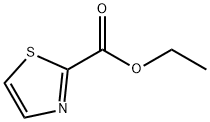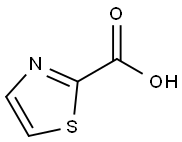ETHYL 1,3-BENZOTHIAZOLE-2-CARBOXYLATE
Synonym(s):2-Benzothiazolecarboxylic acid, ethyl ester
- CAS NO.:32137-76-1
- Empirical Formula: C10H9NO2S
- Molecular Weight: 207.25
- MDL number: MFCD00848360
- SAFETY DATA SHEET (SDS)
- Update Date: 2023-04-23 13:52:06

What is ETHYL 1,3-BENZOTHIAZOLE-2-CARBOXYLATE?
Chemical properties
White to light brown solid
Synthesis Reference(s)
Journal of Heterocyclic Chemistry, 8, p. 257, 1971 DOI: 10.1002/jhet.5570080214
The Journal of Organic Chemistry, 23, p. 1344, 1958 DOI: 10.1021/jo01103a029
Properties of ETHYL 1,3-BENZOTHIAZOLE-2-CARBOXYLATE
| Melting point: | 68-72 °C |
| Boiling point: | 312.8±25.0 °C(Predicted) |
| Density | 1.290±0.06 g/cm3(Predicted) |
| storage temp. | Sealed in dry,Room Temperature |
| pka | -1.07±0.10(Predicted) |
| color | Pale yellow |
| λmax | 287nm(CHCl3)(lit.) |
Safety information for ETHYL 1,3-BENZOTHIAZOLE-2-CARBOXYLATE
| Signal word | Danger |
| Pictogram(s) |
 Skull and Crossbones Acute Toxicity GHS06  Health Hazard GHS08 |
| GHS Hazard Statements |
H315:Skin corrosion/irritation H317:Sensitisation, Skin H319:Serious eye damage/eye irritation H330:Acute toxicity,inhalation H334:Sensitisation, respiratory H351:Carcinogenicity H370:Specific target organ toxicity, single exposure H372:Specific target organ toxicity, repeated exposure H412:Hazardous to the aquatic environment, long-term hazard |
| Precautionary Statement Codes |
P201:Obtain special instructions before use. P202:Do not handle until all safety precautions have been read and understood. P260:Do not breathe dust/fume/gas/mist/vapours/spray. P264:Wash hands thoroughly after handling. P264:Wash skin thouroughly after handling. P270:Do not eat, drink or smoke when using this product. P271:Use only outdoors or in a well-ventilated area. P272:Contaminated work clothing should not be allowed out of the workplace. P273:Avoid release to the environment. P280:Wear protective gloves/protective clothing/eye protection/face protection. P284:Wear respiratory protection. P302+P352:IF ON SKIN: wash with plenty of soap and water. P305+P351+P338:IF IN EYES: Rinse cautiously with water for several minutes. Remove contact lenses, if present and easy to do. Continuerinsing. P333+P313:IF SKIN irritation or rash occurs: Get medical advice/attention. P337+P313:IF eye irritation persists: Get medical advice/attention. P405:Store locked up. P403+P233:Store in a well-ventilated place. Keep container tightly closed. |
Computed Descriptors for ETHYL 1,3-BENZOTHIAZOLE-2-CARBOXYLATE
New Products
Tert-butyl bis(2-chloroethyl)carbamate (S)-3-Aminobutanenitrile hydrochloride N-Boc-D-alaninol N-BOC-D/L-ALANINOL N-octanoyl benzotriazole 4-Hydrazinobenzoic acid 3,4-Dibenzyloxybenzaldehyde Electrolytic Iron Powder 1,1’-CARBONYLDIIMIDAZOLE R-2-BENZYLOXY PROPIONIC ACID 4-HYDROXY BENZYL ALCOHOL 1,1’-CARBONYLDI (1,2-4 TRIAZOLE) S-2-CHLORO PROPIONIC ACID (2-Hydroxyphenyl)acetonitrile 4-Bromopyrazole 5-BROMO-2CYANO PYRIDINE 5,6-Dimethoxyindanone 5-broMo-2-chloro-N-cyclopentylpyriMidin-4-aMine 3-(2,4-Dimethoxybenzyl)dihydropyrimidine-2,4(1H,3H)-dione 6-Bromo-3-iodo-1-methyl-1H-indazole 4-Ethylbenzylamine N-(5-Amino-2-methylphenyl)acetamide 2-(BOC-Amino)4-picoline 1-(4-Methylphenylsulfonyl)-1H-1,2,3-benzotriazoleRelated products of tetrahydrofuran








You may like
-
 Ethyl Benzothiazole-2-carboxylate CAS 32137-76-1View Details
Ethyl Benzothiazole-2-carboxylate CAS 32137-76-1View Details
32137-76-1 -
 Ethyl 1,3-benzothiazole-2-carboxylate 98% (GC) CAS 32137-76-1View Details
Ethyl 1,3-benzothiazole-2-carboxylate 98% (GC) CAS 32137-76-1View Details
32137-76-1 -
 Ethyl 1,3-benzothiazole-2-carboxylate 96% CAS 32137-76-1View Details
Ethyl 1,3-benzothiazole-2-carboxylate 96% CAS 32137-76-1View Details
32137-76-1 -
 100-71-0 99%View Details
100-71-0 99%View Details
100-71-0 -
 2-ethyl-6-methyl-3-hydroxypyridine succinate 127464-43-1 99%View Details
2-ethyl-6-methyl-3-hydroxypyridine succinate 127464-43-1 99%View Details
127464-43-1 -
 13162-05-5 N-Vinylformamide 99%View Details
13162-05-5 N-Vinylformamide 99%View Details
13162-05-5 -
 1446013-08-6 98%View Details
1446013-08-6 98%View Details
1446013-08-6 -
 Ste-Glu-AEEA-AEEA-OSUView Details
Ste-Glu-AEEA-AEEA-OSUView Details
1169630-40-3
Statement: All products displayed on this website are only used for non medical purposes such as industrial applications or scientific research, and cannot be used for clinical diagnosis or treatment of humans or animals. They are not medicinal or edible.